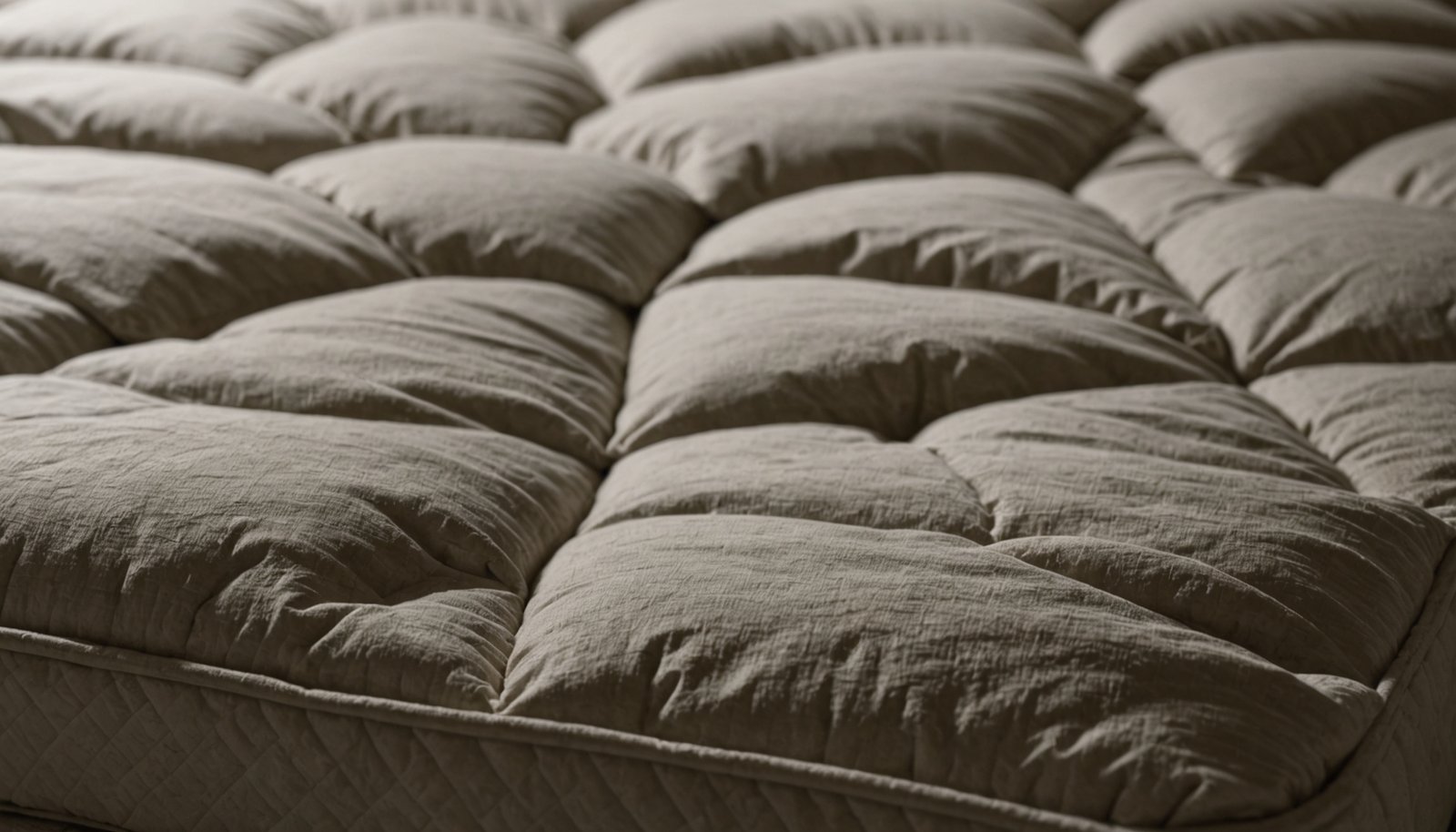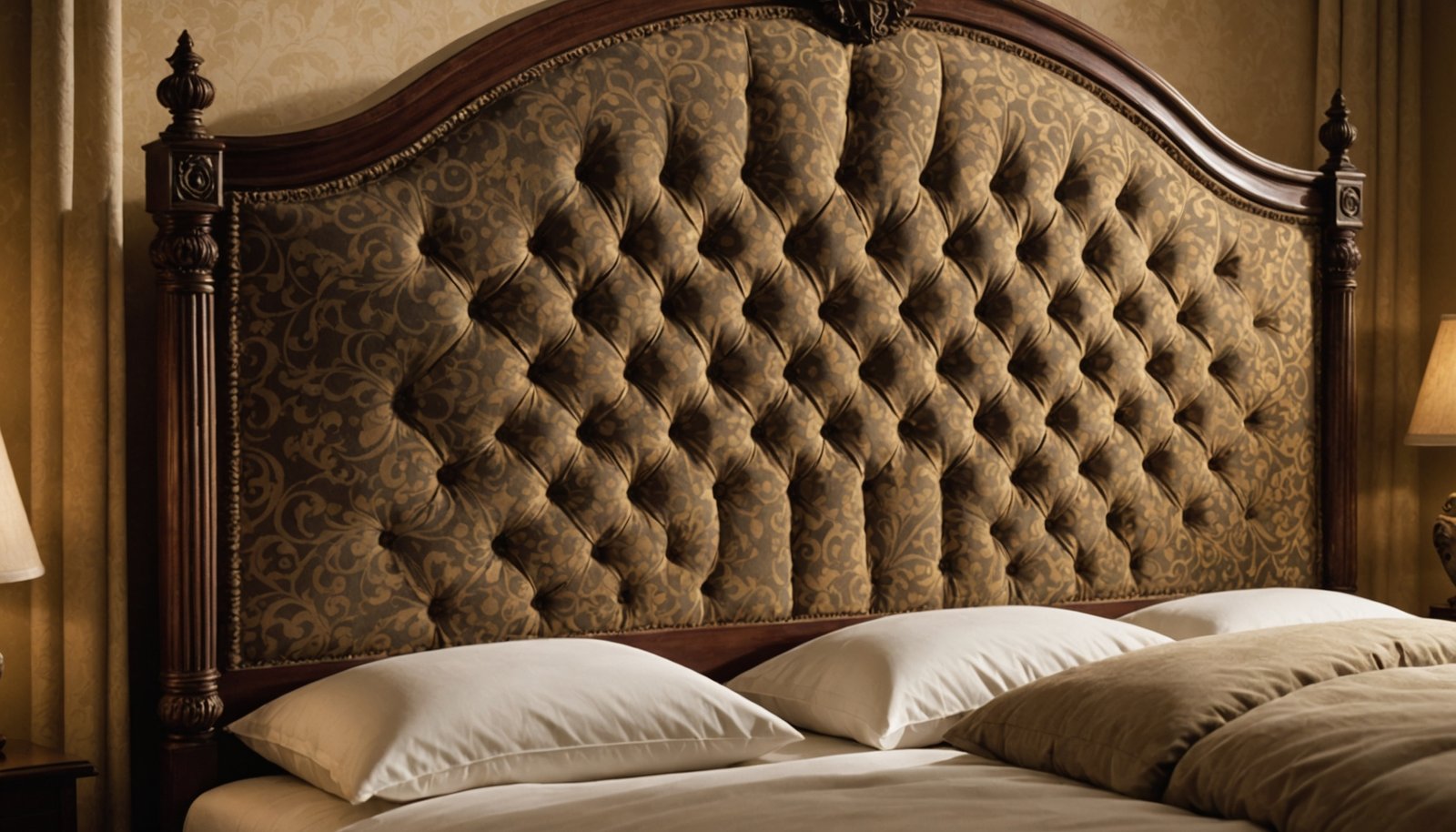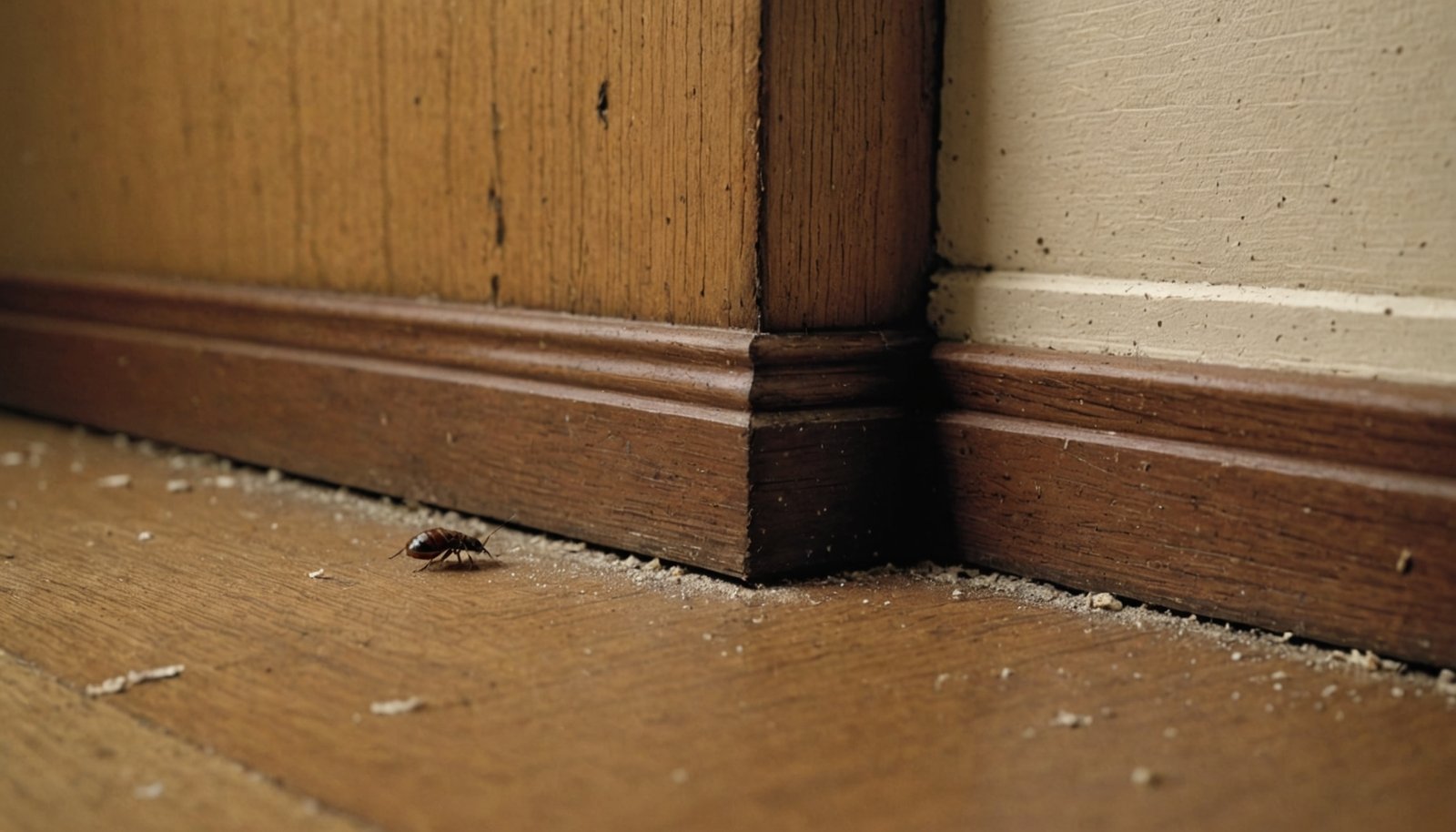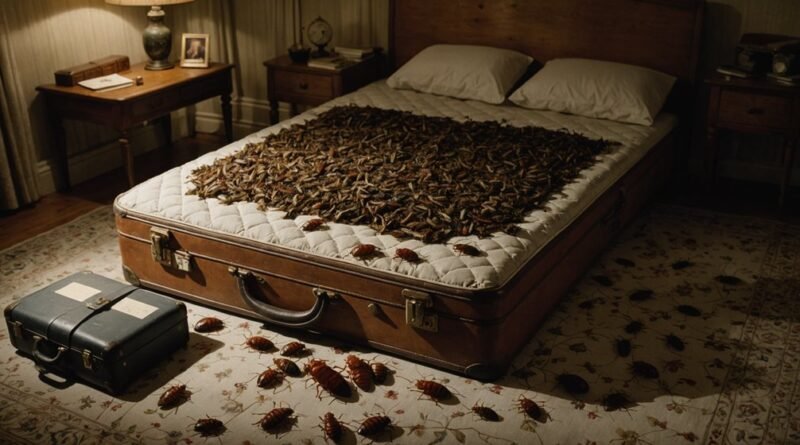Where Bed Bugs Hide: 12 Places They Live in Homes, Cars & Luggage
Bed bugs squeeze into tight seams and cracks you rarely check. Inspect mattress piping, labels, and box spring frames. Check headboards, bed frames, and baseboards’ top lips. Look under nightstand and dresser drawers, and along screw holes. Search upholstered couches and chairs at seams, tufts, buttons, and pleats. Don’t forget car seats, floor mats, strollers, and carriers. Vacuum suitcases, luggage linings, backpacks, and store sealed. You’ll spot pepper-like specks, skins, and eggs—and you can find every hiding place next.
Key Takeaways
- Mattresses and box springs: seams, piping, labels, dust covers, and frame joints hide live bugs, eggs, skins, and dark fecal spots.
- Bed frames and headboards: cracks, screw holes, joints, and behind headboards provide tight harborages with dark specks and shed skins.
- Nightstands, dressers, and upholstered furniture: undersides of drawers, tap joints, seams, tufts, buttons, and pleats often conceal nymphs and eggs.
- Walls, baseboards, and carpets: top lip of baseboards, wall cracks, outlets, carpet edges, and tack strips harbor clusters; seal and treat gaps.
- Cars and luggage: seat seams, floor mat crevices, zipper tracks, and suitcase interiors; vacuum, heat-treat, and store luggage sealed after travel.
Mattresses and Box Springs

Mattresses and box springs are bed bugs’ favorite hideouts because they’re close to a steady food source—you. You’ll often find them along mattress seams, piping, and labels, where stitching creates tight shelter.
Flip the mattress and check the underside edges and tufts. Look for rusty spots, pepper-like droppings, shed skins, and tiny white eggs glued in clusters.
Inspect the box spring carefully. Shine a flashlight along the dust cover, corner guards, and the wooden frame’s joints and staples. Bed bugs squeeze into staple holes, fabric folds, and screw recesses.
If you can, remove the dust cover to expose framing where they cluster.
To fight back, encase both pieces with certified bed bug-proof covers, vacuum seams, launder bedding hot, and consider professional treatment if activity persists.
Bed Frames and Headboards

Check your bed frame and headboard for bed bugs hiding in cracks and crevices you might miss at a glance.
Run a flashlight and card along tufted upholstery seams where eggs and skins collect.
Inspect screw holes and joints closely, since these tight spaces shelter clusters.
Cracks and Crevices
Although bed bugs often hide in mattresses, they’re just as likely to squeeze into the tiny cracks and crevices of bed frames and headboards. You’ll find them along screw holes, bolt recesses, joints, and decorative trim where wood or metal meets. They wedge into gaps as thin as a credit card, staying close to where you sleep so they can feed and retreat unnoticed.
Focus on tight seams and joints. Run a card along gaps, use a flashlight, and check for rust-colored spots, shed skins, and eggs glued to rough surfaces. Seal, tighten, and caulk where feasible to reduce harborage.
| Spot | What to Look For | Action |
|---|---|---|
| Screw holes | Dark specks, shells | Remove/inspect screws |
| Bed joints | Fine gaps | Tighten, add caulk |
| Slats ends | Eggs, nymphs | Lift, vacuum |
| Headboard trim | Stains, skins | Pry gently, inspect |
| Brackets | Clustered bugs | Treat, reassemble |
Tufted Upholstery Seams
Tufts and seams on upholstered headboards and bed frames act like built-in hideouts, letting bed bugs nest where fabric folds meet buttons and piping.
You often miss these tight, shadowed pockets because they’re decorative and hard to inspect. Bed bugs wedge into stitch lines, under trim, and behind welting, then emerge at night to feed. Focus your search on the highest-contact areas near where you sleep.
- Run a card or fingernail along piping and button folds; watch for rusty specks, cast skins, or live nymphs.
- Press seams to open gaps; use a flashlight to reveal clusters tucked beneath fabric edges.
- Lift the mattress and scan the top rail of the headboard’s upholstery first.
- Steam slow and deliberate along seams, then encase the headboard if possible.
Screw Holes and Joints
After you inspect fabric folds, turn to the hardware—bed bugs love screw holes, bolt slots, and tight wood or metal joints where pieces meet.
These spots stay dark, protected, and close to where you sleep, giving bugs a perfect harborage. Use a flashlight and a thin probe or old credit card to trace each joint. Look for pepper-like fecal spots, shed skins, eggs, or live nymphs tucked just inside the holes.
Back out screws carefully and check the threads and recesses. If possible, disassemble the headboard and bed frame to expose hidden seams.
Vacuum crevices with a crevice tool, then apply targeted residuals or desiccant dusts into screw channels and joint gaps. Reassemble tightly and install interceptors to catch stragglers and confirm progress.
Baseboards and Trim

Baseboards and trim offer narrow gaps and shadowed ledges where bed bugs hide between feedings.
Baseboards and trim create narrow, shadowed gaps where bed bugs tuck away between feedings.
You’ll find them in the slight space where wood meets wall, behind peeling paint, and inside mitered corners. They like the warm, still air along floor edges and the regular access to you at night. Fecal specks, cast skins, and tiny eggs often dot the lower quarter inch, especially near sleeping areas.
- Inspect the top lip of baseboards with a flashlight; look for dark pinpoints and shed skins.
- Check gaps at expansion joints, door casings, and crown trim where caulk’s missing.
- Probe corner seams and quarter-round with a thin card to flush movement.
- Seal cracks with paintable caulk after cleaning, then monitor with interceptors.
Nightstands and Dressers
Even when you keep surfaces tidy, nightstands and dressers give bed bugs tight seams, screw holes, and shadowed drawer cavities to occupy near your sleeping body.
They slip under drawer bottoms, behind runners, and into cam-lock connectors. You’ll also find them tucked along back panels, beneath felt pads, and under knob escutcheons. Their flattened bodies let them hide behind lifting veneer or where hardware meets wood.
Check with a flashlight and a thin card. Remove drawers, inspect undersides, and tap joints to dislodge debris. Look for rust-colored specks, pale shed skins, tiny eggs, and live bugs clustered in corners.
Vacuum cracks, then seal crevices with wood putty or caulk. Tighten loose hardware, replace chipped edging, and consider interceptors under legs to monitor activity.
Upholstered Couches and Chairs
Upholstered couches and chairs hide bed bugs in seams, piping, tufts, under dust covers, and inside screw joints.
You’ll spot telltale signs like dark fecal dots, shed skins, tiny eggs near stitching, and itchy bites after sitting.
Inspect with a flashlight and credit card edge, then treat by vacuuming seams, steaming, laundering removable covers on high heat, and using encasements or calling a pro.
Common Hiding Crevices
Although they look inviting, couches and armchairs offer bed bugs countless seams and shadows to exploit. You’re dealing with flat, tight spaces where these insects can wedge themselves close to their hosts. Focus on spots that stay dark, warm, and undisturbed, especially where fabric meets rigid frames or moving parts rub together.
1) Lift cushions and inspect zipper folds, piping, and welts. Bed bugs slip under zipper flaps and ride seams that run the cushion’s edge.
2) Check beneath dust covers (cambric) on the underside. Staples, tacks, and frame joints create narrow ledges.
3) Examine tufts, buttons, and pleats. These compressible folds hold eggs and nymphs between stitches.
4) Probe recliner mechanisms and hollow arms. Metal brackets, screw heads, and internal channels provide tight harborages near frequent sitting.
Signs of Infestation
Four telltale clues give away bed bugs in couches and chairs: dark fecal spots, shed skins, eggs, and live bugs. You’ll notice pepper-like stains along seams, piping, and under cushions; they smear reddish-brown when damp.
Molted skins look like papery, translucent shells tucked in stitching and zipper folds. Pearly eggs, about a millimeter long, cluster in hidden fabric creases and stapled dust covers.
You might also spot slow-moving, apple-seed–sized bugs emerging at dusk near your favorite sitting spot. Sweet, musty odor can hang around heavy infestations.
Look for tiny blood specks on throws or clothing after sitting. New, unexplained itchy bites in rows or clusters on exposed skin can align with recent couch time. Pet rest areas on furniture often mirror these signs.
Inspection and Treatment
Start with a focused, methodical check, then move straight to control. Slide a flashlight and thin card along seams, welts, and under cushions. Lift cushions, unzip covers, and inspect stapled dust cloths beneath chairs. Look for live bugs, peppery fecal spots, shed skins, and eggs tucked in tufts and screw joints. Isolate the piece from walls to reduce dispersal.
- Vacuum seams, buttons, and frames slowly with a crevice tool; immediately bag and discard the contents.
- Steam at 160–180°F across seams and folds, moving 1 inch per second; let the piece dry thoroughly.
- Apply labeled residuals or dusts to hidden cracks (not seating surfaces); follow product directions.
- Encapsulate with bed bug–rated furniture encasements; monitor with interceptors and weekly rechecks.
Curtains and Window Frames
Curtains and window frames give bed bugs quiet, fabric-rich hiding spots right next to where you sleep or sit.
You’ll often find them along curtain hems, pleats, and header tapes where stitches create tight seams. They wedge into the folds near hooks and rings, hide behind tiebacks, and slip into the top pocket of blackout liners.
On window frames, they squeeze into gaps under trim, around sash stops, and beneath chipped paint.
Bed bugs slip into window frame gaps—under trim, around sash stops, and beneath chipped paint.
Check at night with a flashlight, starting at the curtain top and moving down each fold. Look for pepper-like fecal spots, pale shed skins, and tiny eggs along seams.
Launder washable curtains on high heat, then dry on high. Vacuum rod brackets and frame edges, then seal loose trim and reattach securely.
Wall Cracks and Electrical Outlets
Wall cracks and electrical outlets give bed bugs dark, tight harborage near your resting spots, and warm wiring channels can help them spread between rooms.
You’ll often spot signs around outlet plates and baseboards if they’re using these gaps as hidden highways.
Seal cracks, caulk gaps, and install outlet seals to cut off access and slow infestations.
Why Outlets Attract Bed Bugs
Peek behind the faceplate, and you’ll find exactly what bed bugs want: dark, tight gaps that stay undisturbed. Outlets and the voids around them mimic seam-like refuges where pests wedge in, digest meals, and lay eggs out of sight. You often sleep nearby, so they don’t travel far for a blood meal. Warmth from wiring and the steady microclimate also help them thrive between feedings.
Here’s why outlets are irresistible:
- Proximity to hosts: outlets cluster near beds and sofas, shortening nightly travel.
- Harborage geometry: screw holes, box edges, and cable penetrations create snug crevices.
- Stable conditions: reduced airflow preserves humidity and temperature they prefer.
- Movement highways: conduit chases and wall voids let them spread between rooms unnoticed.
You’ll overlook them unless you check.
Sealing Cracks and Gaps
Even if you’re vigilant about clutter and laundering, bed bugs slip through hairline openings, so you’ve got to seal their entry points. Start with walls: run a flashlight along baseboards, trim, and window frames to spot gaps. Use paintable latex caulk for small cracks and polyurethane sealant for wider seams. For deep voids, backer rod improves fill and durability.
Shut off power before removing outlet and switch plates. Install gasket-style outlet seals, then caulk the plate’s perimeter to block harborage. Replace missing screw anchors and tighten loose covers so bugs can’t slip behind.
- Vacuum crevices first.
- Seal, then repaint to lock edges.
- Recheck seasonally as buildings shift.
| Crack Line | Outlet Gap | Baseboard Shadow |
|---|---|---|
| Hairline fissure | Loose plate edge | Dark seam |
| Fresh caulk bead | Foam gasket | Trim caulked |
| Sealed smooth | Screws snug | Gap closed |
Rugs and Carpet Edges
Although you might vacuum regularly, bed bugs can still slip into the narrow seams where rugs meet baseboards and along carpet edges.
These tight borders offer shelter, warmth, and quick access to hosts at night. You’ll often miss them if you only clean the rug’s surface. Focus on the junction lines, tack strips under wall-to-wall carpet, and the binding on area rugs.
1) Pull back carpet edges gently and inspect tack strips, staples, and padding seams with a flashlight and credit card to probe gaps.
2) Steam along edges at 160–180°F, then vacuum with a crevice tool; discard vacuum contents in a sealed bag.
3) Apply silica aerogel or diatomaceous earth lightly along baseboards and edges.
4) Seal loose carpet junctions and reattach edging to reduce harborage.
Car Seats and Floor Mats
Two overlooked zones in your daily commute can harbor bed bugs: car seats and floor mats.
These pests slip into seams, stitching, and the narrow crevices where seat backs meet cushions. They also wedge under plastic trim, seat-rail tracks, and the folds of seatbelts.
Floor mats collect shed skins and fecal spots, especially along edges and beneath pedals where debris accumulates.
Inspect with a flashlight. Lift mats, slide seats forward and back, and check the piping and zippers on covers. Look for rust-colored smears, pepper-like droppings, tiny white eggs, or live bugs.
Vacuum slowly with crevice tools, then bag the vacuum contents. Launder removable covers on hot and dry them high-heat.
For stubborn activity, consider steam at 160–180°F and follow with targeted residual sprays labeled for vehicles.
Strollers and Carriers
Strollers and baby carriers can ferry bed bugs from place to place without you noticing. These pests slip into tight seams, fabric folds, and under padding, then hitch rides to daycare, parks, or your entryway.
You’ll rarely spot adults; instead, look for tiny black fecal spots, pale shed skins, or pinhead eggs clinging to stitching.
- Inspect regularly: check canopy seams, harness slots, underside frames, wheel housings, and storage baskets with a flashlight.
- Clean smart: vacuum crevices with a crevice tool, then launder removable fabrics on high heat; wipe frames with hot, soapy water.
- Quarantine used gear: bag and isolate secondhand strollers or carriers until you’ve inspected and heat-treated washable parts.
- On-the-go prevention: avoid parking on upholstered surfaces, minimize fabric clutter in baskets, and store gear off bedroom floors.
Suitcases and Luggage Linings
Just like nursery gear can ferry pests, your suitcase makes an easy shuttle for bed bugs hiding in seams and linings. They slip into zipper folds, piping, luggage feet, and the fabric underlayment. You won’t always see them; look for pepper-like specks, shed skins, or faint blood smears. When you travel, keep bags off beds and carpets, inspect hotel luggage racks, and use hard-sided cases if you can.
- Before packing: vacuum the interior, check seams with a flashlight.
- On return: unpack in a garage or laundry room, then tumble-dry washable items on high heat.
- Store sealed: bag the suitcase or use a tight closet, away from sleeping areas.
| Risk Spot | What To Look For | Action |
|---|---|---|
| Seams/Linings | Specks, shells | Vacuum, steam |
| Zippers/Piping | Live bugs | Seal, inspect |
| Luggage Feet | Smears | Wipe, isolate |
Backpacks and Travel Accessories
Although they seem harmless, backpacks, totes, and travel pillows can quietly ferry bed bugs between home, school, and hotels. You carry them daily, set them on floors, slide them under seats, and store them beside beds—exactly where bed bugs thrive.
Backpacks, totes, and travel pillows can quietly shuttle bed bugs between home, school, and hotels.
These pests squeeze into seams, zipper covers, foam crevices, and strap folds, then hitch a ride to your couch or mattress.
To reduce risk, act before and after each trip:
1) Inspect seams, zipper tracks, and pockets with a flashlight; look for pepper-like spots or shed skins.
2) Heat-treat soft items: tumble dry on high for 30 minutes; avoid washing-only cycles.
3) Store bags in sealed bins or large zip bags, not on beds or carpets.
4) Choose smooth, light-colored, washable materials; avoid heavy piping and deep padding.
Conclusion
You know where bed bugs hide now, so don’t give them a chance. Check seams, cracks, and crevices, and vacuum regularly. Encase your mattress, reduce clutter, and launder bedding and travel items on high heat. Inspect furniture, luggage, car seats, and backpacks after trips. If you spot signs—stains, shells, or bites—act fast with targeted treatments or call a pro. With consistent vigilance and smart habits, you’ll prevent infestations and keep your home, car, and gear bed bug–free.

